NA61/SHINE Experiment—Program beyond 2020
Abstract
:1. Introduction
Results of Initial NA61/SHINE Research
2. New Measurements Requested
- Measurements of charm hadron production in Pb + Pb collisions for heavy ion physics;
- measurements of nuclear fragmentation cross-section for cosmic ray physics;
- measurements of hadron production in hadron–nucleus interactions for neutrino physics.
- RHIC BES fixed-target ( GeV ): Measurement not considered in the current program [27];
- NICA ( GeV): Measurements during stage 2 (after 2023) are under consideration [28];
- J-PARC-HI ( GeV): Under consideration, may be possible after 2025 [29];
- FAIR SIS-100 ( ): Not possible due to the very low cross-section at SIS-100, charm measurements are planned with SIS-300 ( GeV), but not with the start version (timeline is unclear).
- Energies at which the transition from confined hadrons to quark gluon plasma in heavy ion collisions takes place—the onset of deconfinement [30];
- proton beams of momenta used to produce neutrino beams at J-PARC, Japan and Fermilab, US [31];
- light nuclei at momenta > 10 A GeV/c, important for the understanding of the propagation of cosmic rays in the Galaxy [32].
Specific Research Goals
Funding
Conflicts of Interest
Abbreviations
| CERN | Conseil Europén pour la Recherche Nucléaire |
| CP | critical point |
| FAIR | Facility for Antiproton and Ion Research |
| HG | hadron gas |
| HIC | heavy-ion collision |
| J-PARC | Japan Proton Accelerator Research Complex |
| LHC | Large Hadron Collider |
| LS | long shutdown |
| NICA | Nuclotron-based Ion Collider fAcility |
| QCD | quantum chromodynamics |
| QGP | quark-gluon plasma |
| SAVD | small acceptance vertex detector |
| RHIC | Relativistic Heavy Ion Collider |
| SPS | Super Proton Synchrotron |
References
- Gazdzicki, M.; Fodor, Z.; Vesztergombi, G. NA49-future Collaboration. In Study of Hadron Production in Hadron-Nucleus and Nucleus-Nucleus Collisions at the CERN SPS; Technical Report CERN-SPSC-2006-034; SPSC-P-330; CERN: Geneva, Switzerland, 2006. [Google Scholar]
- Abgrall, N. NA61/SHINE Collaboration. In Calibration and Analysis of the 2007 Data; Technical Report CERN-SPSC-2008-018; CERN: Geneva, Switzerland, 2008. [Google Scholar]
- Barducci, A.; Casalbuoni, R.; De Curtis, S.; Gatto, R.; Pettini, G. Chiral Symmetry Breaking in QCD at Finite Temperature and Density. Phys. Lett. B 1989, 231, 463–470. [Google Scholar] [CrossRef]
- Halasz, A.M.; Jackson, A.D.; Shrock, R.E.; Stephanov, M.A.; Verbaarschot, J.J.M. Phase diagram of QCD. Phys. Rev. D 1998, 58, 096007. [Google Scholar] [CrossRef]
- Berges, J.; Rajagopal, K. Color superconductivity and chiral symmetry restoration at nonzero baryon density and temperature. Nucl. Phys. B 1999, 538, 215–232. [Google Scholar] [CrossRef]
- Bazavov, A.; Bhattacharya, T.; DeTar, C.; Ding, H.-T.; Gottlieb, S.; Gupta, R.; Hegde, P.; Heller, U.M.; Karsch, F.; Laermann, E.; et al. Equation of state in (2+1)-flavor QCD. Phys. Rev. D 2014, 90, 094503. [Google Scholar] [CrossRef] [Green Version]
- Bazavov, A.; Ding, H.-T.; Hegde, P.; Kaczmarek, O.; Karsch, F.; Laermann, E.; Maezawa, Y.; Ohno, H.; Petreczky, P.H.; Wagner, M.; et al. The QCD Equation of State to () from Lattice QCD. Phys. Rev. D 2017, 95, 054504. [Google Scholar] [CrossRef]
- Caines, H. The Search for Critical Behavior and Other Features of the QCD Phase Diagram—Current Status and Future Prospects. Nucl. Phys. A 2017, 967, 121–128. [Google Scholar] [CrossRef]
- Abgrall, N.; Aduszkiewicz, A.; Andrieu, B.; Anticic, T.; Antoniou, N.; Argyriades, J.; Asryan, A.G.; Baatar, B.; Blondel, A.; Blumer, J.; et al. (NA61/SHINE Collaboration). Measurements of Cross Sections and Charged Pion Spectra in Proton-Carbon Interactions at 31 GeV/c. Phys. Rev. C 2011, 84, 034604. [Google Scholar] [CrossRef]
- Abraham, J.; Aglietta, M.; Aguirre, I.C.; Albrow, M.; Allard, D.; Allekotte, I.; Allison, P.; Alvarez Muñiz, J.; do Amaral, M.G.; Ambrosio, M.; et al. (Pierre Auger Collaboration). Properties and performance of the prototype instrument for the Pierre Auger Observatory. Nucl. Instrum. Methods Phys. Res. Sect. A 2004, 523, 50–95. [Google Scholar] [CrossRef]
- Antoni, T.; Apel, W.D.; Badea, F.; Bekk, K.; Bercuci, A.; Blümer, H.; Bozdog, H.; Brancus, I.M.; Büttner, C.; Chilingarian, A.; et al. (KASCADE Collaboration). The Cosmic ray experiment KASCADE. Nucl. Instrum. Methods Phys. Res. Sect. A 2003, 513, 490–510. [Google Scholar] [CrossRef]
- Morison, I. Introduction to Astronomy and Cosmology; John Wiley & Sons: Hoboken, NJ, USA, 2008; ISBN 978-0-470-03333-3. [Google Scholar]
- Turko, L. (NA61/SHINE Collaboration) Looking for the Phase Transition-Recent NA61/SHINE Results. Universe 2018, 4, 52. [Google Scholar] [CrossRef]
- Aduszkiewicz, A. (NA61/SHINE Collaboration Collaboration). In Report from the NA61/SHINE Experiment at the CERN SPS; Technical Report CERN-SPSC-2017-038; SPSC-SR-221; CERN: Geneva, Switzerland, 2017. [Google Scholar]
- Becattini, F.; Manninen, J.; Gazdzicki, M. Energy and system size dependence of chemical freeze-out in relativistic nuclear collisions. Phys. Rev. 2006, C73, 044905. [Google Scholar] [CrossRef]
- Begun, V.V.; Gazdzicki, M.; Gorenstein, M.I.; Hauer, M.; Konchakovski, V.P.; Lungwitz, B. Multiplicity fluctuations in relativistic nuclear collisions: Statistical model versus experimental data. Phys. Rev. 2007, C76, 024902. [Google Scholar] [CrossRef]
- Larsen, D. (NA61/SHINE Collaboration) The onsets of deconfinement and fireball of NA61/SHINE. arXiv, 2018; arXiv:1810.02756. [Google Scholar]
- Aduszkiewicz, A.; Andronov, E.; Antićić, T.; Antoniou, N.; Baatar, B.; Baszczyk, M.; Bhosale, S.; Blondel, A.; Bogomilov, M.; Brandin, A.; et al. (NA61/SHINE Collaboration) Measurements of total production cross sections for π++C, π++Al, K++C, and K++Al at 60 GeV/c and π++C and π++Al at 31 GeV/c. Phys. Rev. D 2018, 98, 052001. [Google Scholar] [CrossRef]
- Andronov, E. (NA61/SHINE Collaboration) Search for the critical point by the NA61/SHINE experiment. arXiv, 2018; arXiv:1807.10737. [Google Scholar]
- Meninno, E. (ALICE Collaboration) Open-charm production measurements in pp, 1 p-Pb and Pb-Pb collisions with ALICE at the LHC. EPJ Web Conf. 2017, 137, 06018. [Google Scholar] [CrossRef]
- Hou, G.W.S. (ATLAS, CMS Collaboration) Open charm production and spectroscopy at ATLAS and CMS. Proc. Sci. 2016. [Google Scholar] [CrossRef]
- Simko, M. (STAR Collaboration) Measurements of open charm hadrons at the STAR experiment. J. Phys. Conf. Ser. 2017, 832, 012028. [Google Scholar] [CrossRef]
- Nagashima, K. (PHENIX Collaboration) PHENIX measurements of single electrons from charm and bottom decays at midrapidity in Au+Au collisions. Nucl. Phys. 2017, A967, 644–647. [Google Scholar] [CrossRef]
- Odyniec, G. The RHIC Beam Energy Scan program in STAR and what’s next…. J. Phys. Conf. Ser. 2013, 455, 012037. [Google Scholar] [CrossRef]
- Yang, C. (STAR Collaboration) The STAR beam energy scan phase II physics and upgrades. Nucl. Phys. 2017, A967, 800. [Google Scholar] [CrossRef]
- Luo, X.; Xu, N. Search for the QCD Critical Point with Fluctuations of Conserved Quantities in Relativistic Heavy-Ion Collisions at RHIC: An Overview. Nucl. Sci. Tech. 2017, 28, 112. [Google Scholar] [CrossRef]
- Meehan, K.C. (STAR Collaboration) Fixed Target Collisions at STAR. Nucl. Phys. 2016, A956, 878. [Google Scholar] [CrossRef]
- Kekelidze, V.; Kovalenko, A.; Lednicky, R.; Matveev, V.; Meshkov, I.; Sorin, A.; Trubnikov, G. Feasibility study of heavy-ion collision physics at NICA JINR. Nucl. Phys. A 2017, 967, 884–887. [Google Scholar] [CrossRef]
- Sako, H.; Harada, H.; Sakaguchi, T.; Chujo, T.; Esumi, S.; Gunji, T.; Hasegawa, S.; Hwang, S.H.; Ichikaw, Y.; Imai, K.; et al. (J-PARC Heavy-Ion Collaboration) Studies of high density baryon matter with high intensity heavy-ion beams at J-PARC. Nucl. Phys. A 2016, 956, 850–853. [Google Scholar] [CrossRef]
- Gazdzicki, M.; Gorenstei, M.; Seyboth, P. Onset of deconfinement in nucleus-nucleus collisions: Review for pedestrians and experts. Acta Phys. Polon. B 2011, 42, 307–351. [Google Scholar] [CrossRef]
- Abgrall, N.; Aduszkiewicz, A.; Andronov, E.V.; Antićić, T.; Baatar, B.; Baszczyk, M.; Bhosale, S.; Blondel, A.; Bogomilov, M.; Brandin, A.; et al. (NA61 Collaboration) Measurements of π±, K± and proton yields from the surface of the T2K replica target for incoming 31 GeV/c protons with the NA61/SHINE spectrometer at the CERN SPS. arXiv, 2018; arXiv:1808.04927. [Google Scholar]
- Genolini, Y.; Maurin, D.; Moskalenko, I.V.; Unger, M. Current status and desired accuracy of the isotopic production cross sections relevant to astrophysics of cosmic rays I. Li, Be, B, C, N. Phys. Rev. C 2018, 98, 034611. [Google Scholar] [CrossRef]
- Snoch, A. (NA61/SHINE Collaboration) Charm Program of NA61/SHINE: Motivation and Measurements. arXiv, 2018; arXiv:1803.01692. [Google Scholar]
- Kaptur, E. (NA61/SHINE Collaboration) Energy scan with Be+Be collisions: Cross-section, centrality determination, pion spectra and mean multiplicities, CPOD2014. Proc. Sci. 2015, 053. [Google Scholar]
- Aduszkiewicz, A. (NA61/SHINE Collaboration). In Feasibility Study for the Measurement of Nuclear Fragmentation Cross Sections with NA61/SHINE at the CERN SPS; CERN-SPSC-2017-035; SPSC-P-330-ADD-9; CERN: Geneva, Switzerland, 2017. [Google Scholar]
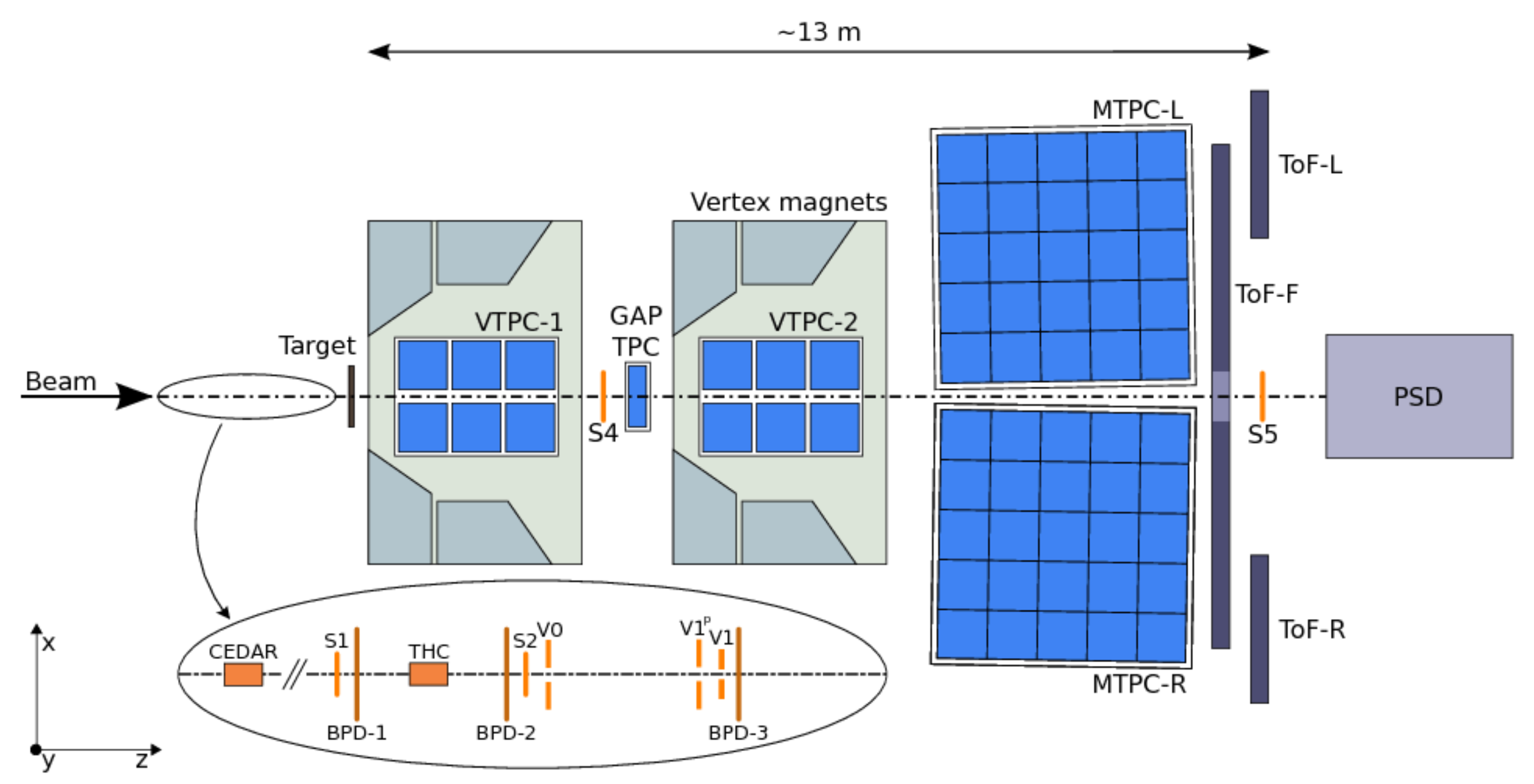
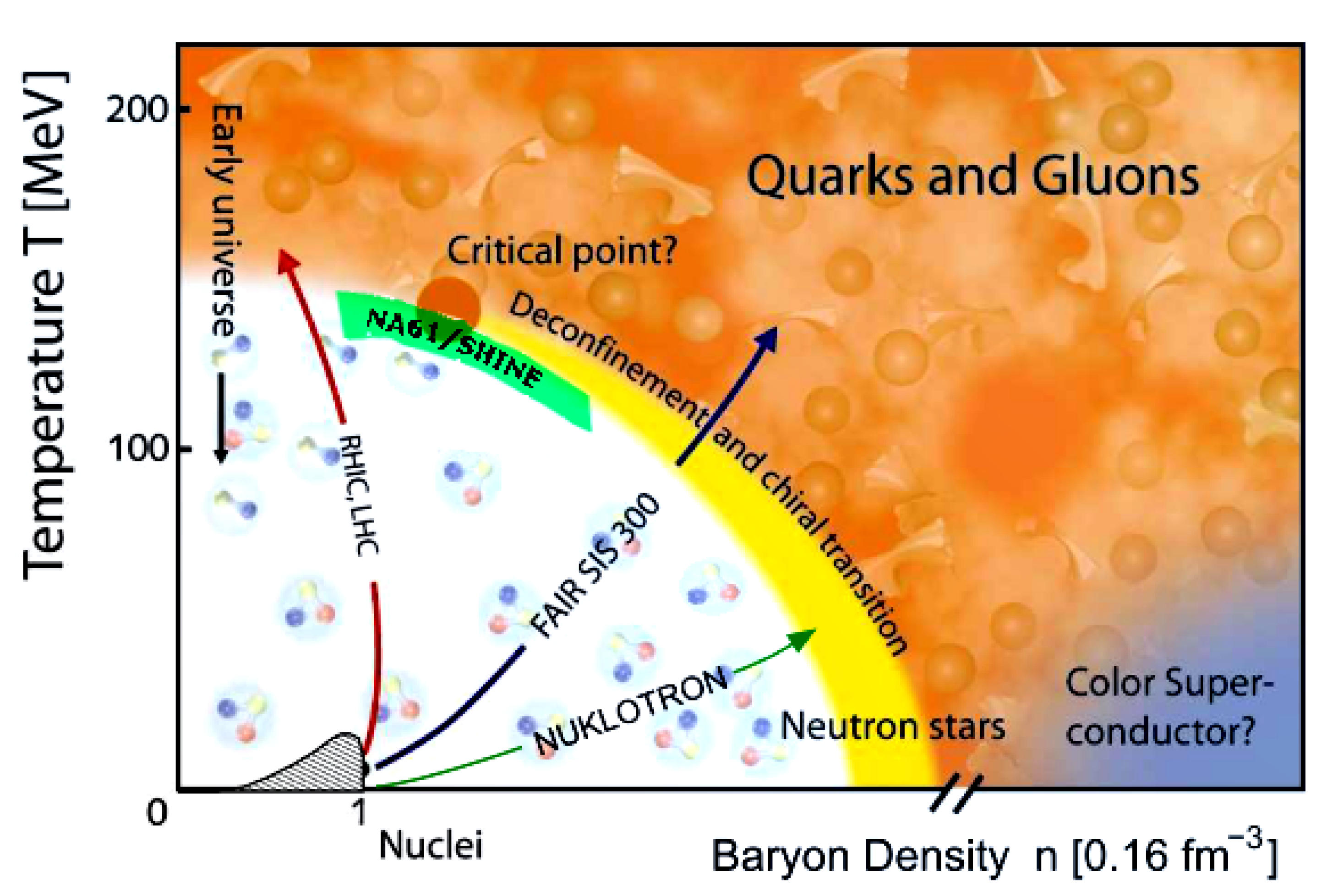
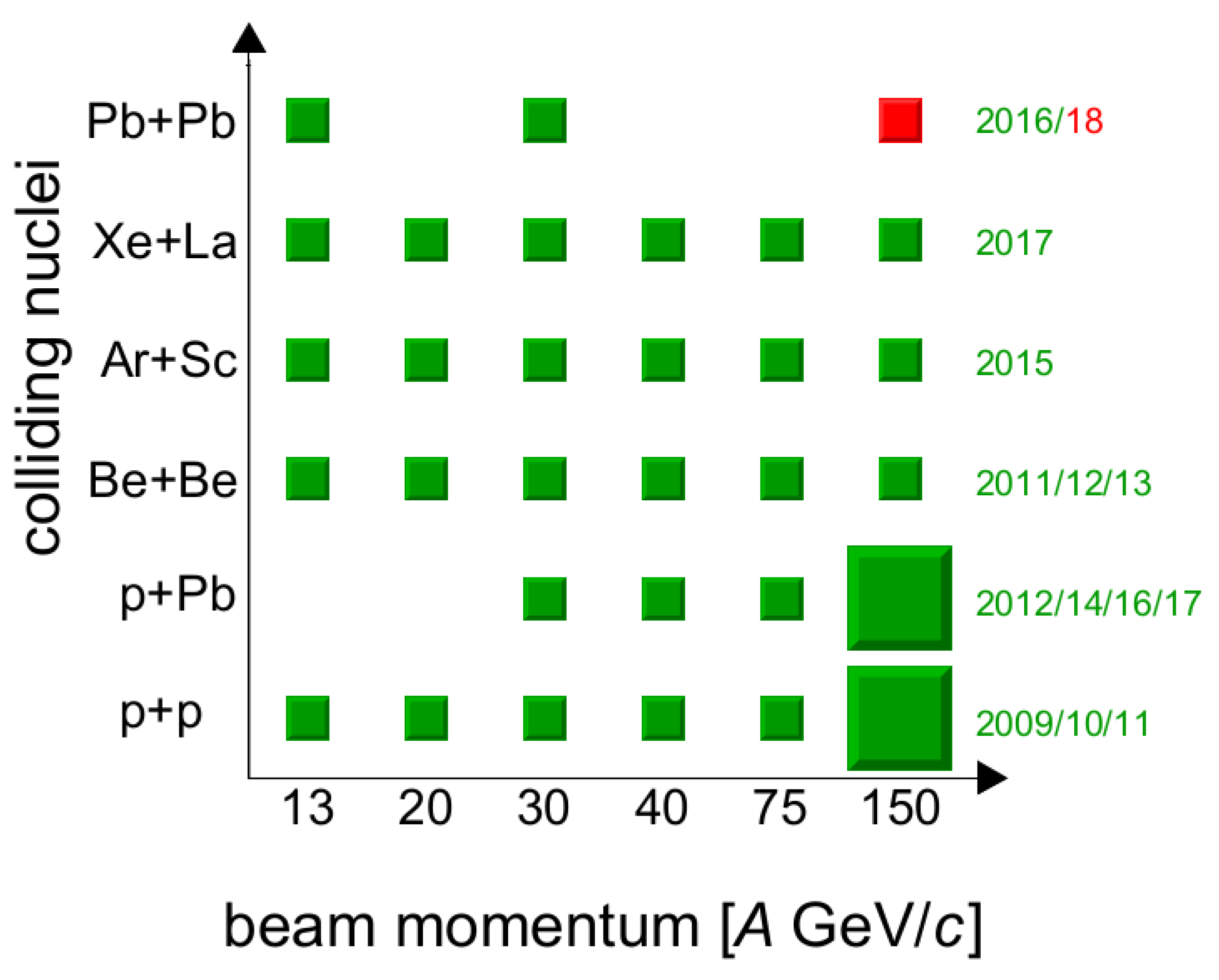
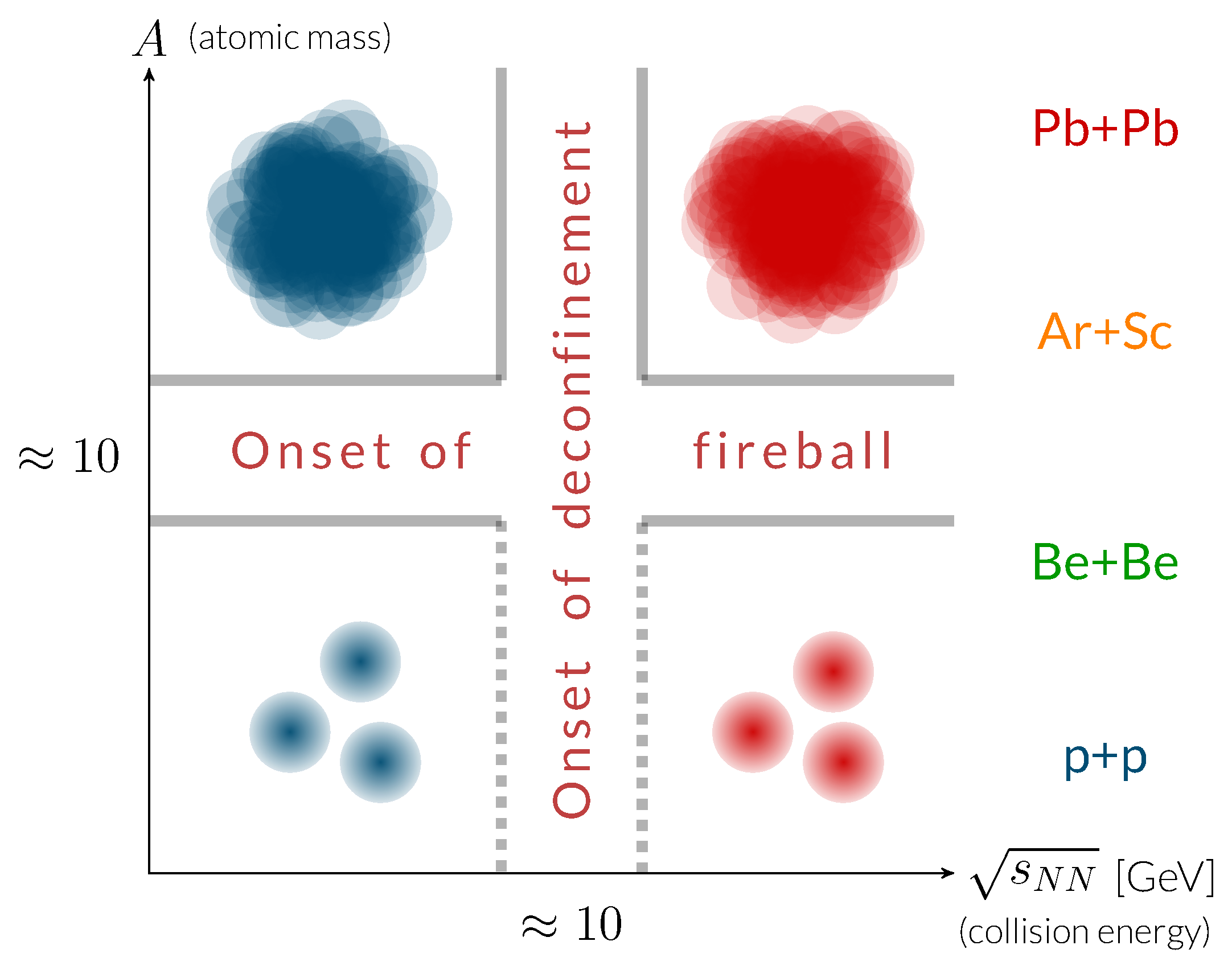
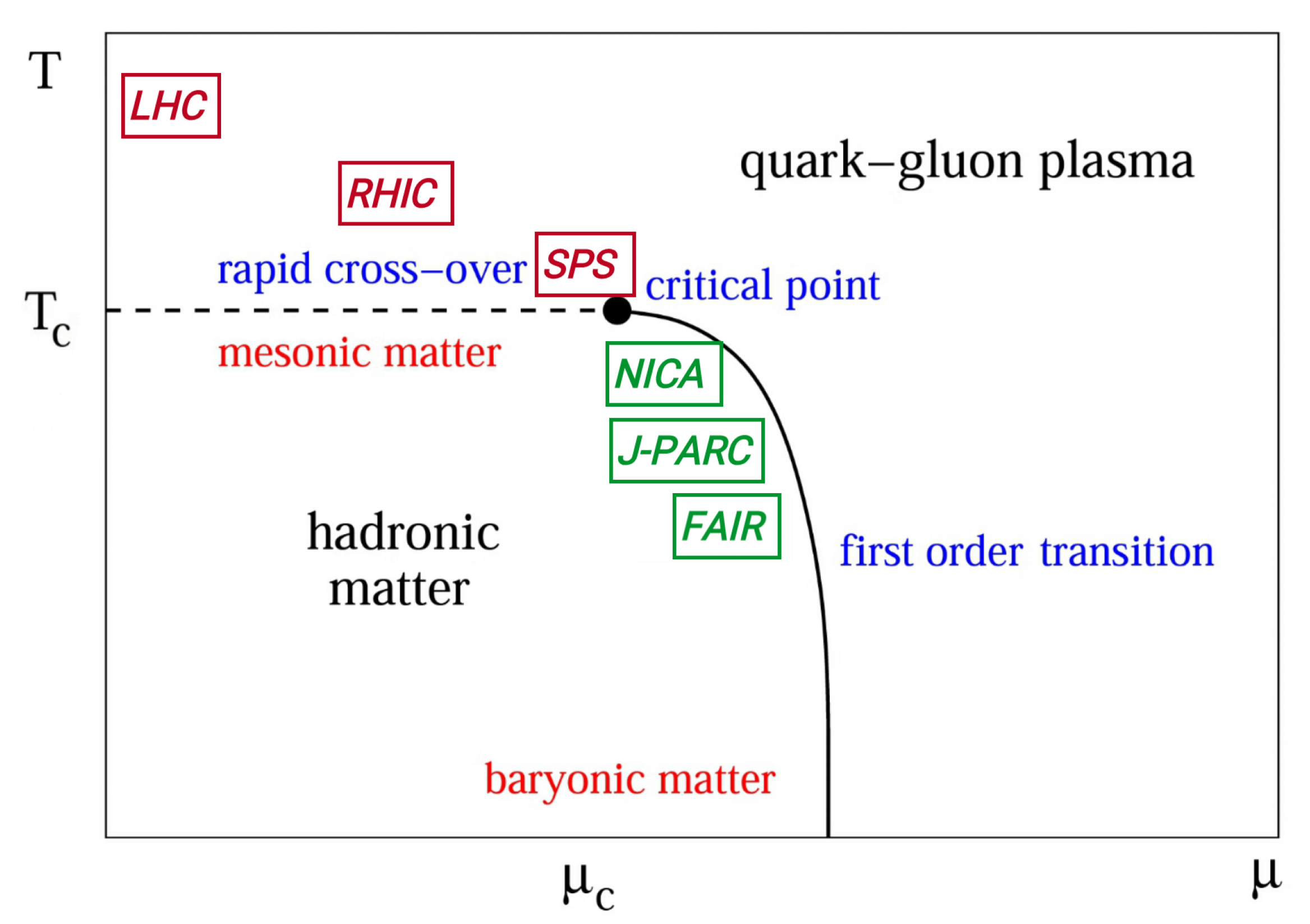
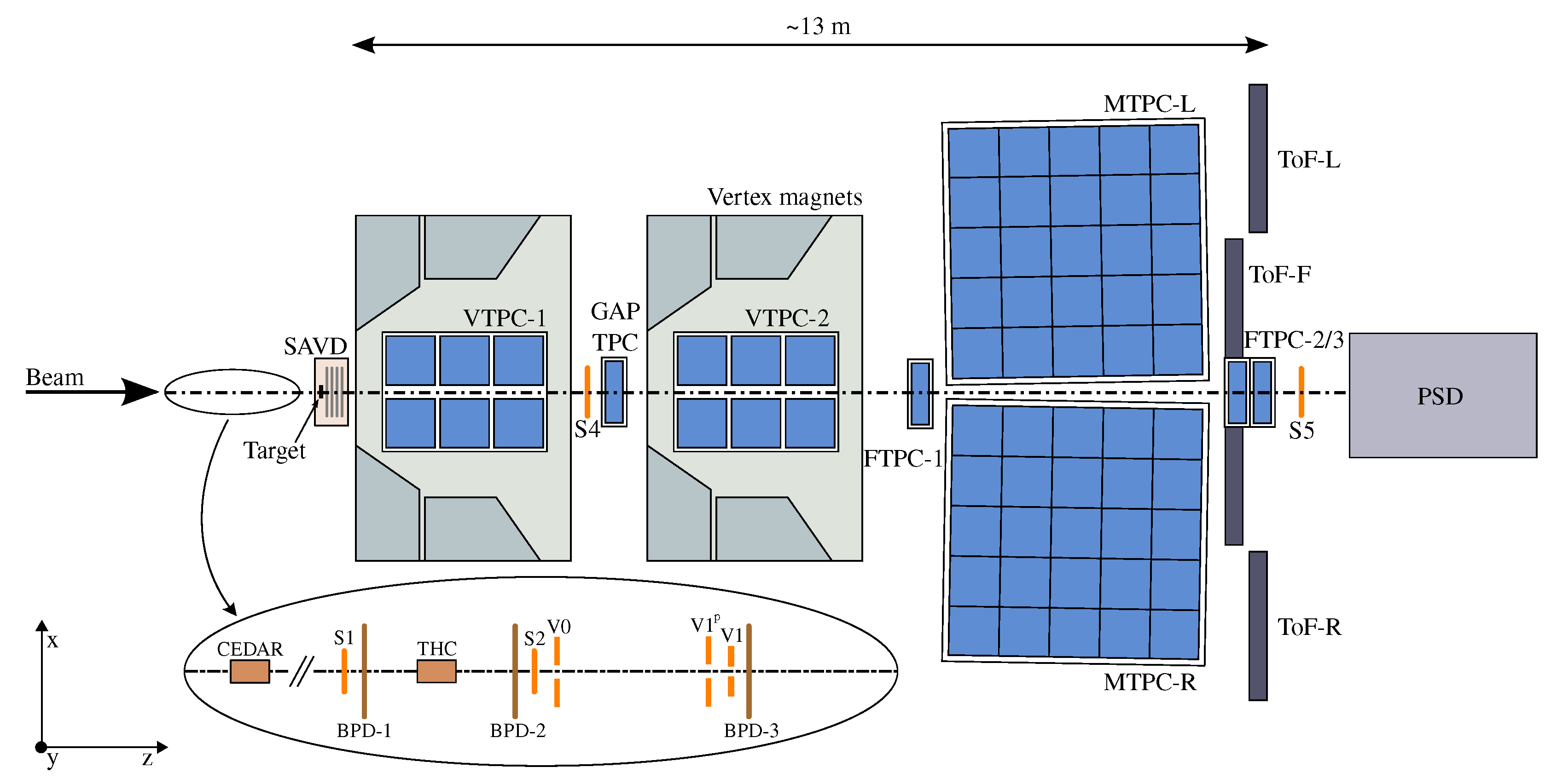
© 2018 by the author. Licensee MDPI, Basel, Switzerland. This article is an open access article distributed under the terms and conditions of the Creative Commons Attribution (CC BY) license (http://creativecommons.org/licenses/by/4.0/).
Share and Cite
Turko, L. NA61/SHINE Experiment—Program beyond 2020. Particles 2018, 1, 296-304. https://doi.org/10.3390/particles1010024
Turko L. NA61/SHINE Experiment—Program beyond 2020. Particles. 2018; 1(1):296-304. https://doi.org/10.3390/particles1010024
Chicago/Turabian StyleTurko, Ludwik. 2018. "NA61/SHINE Experiment—Program beyond 2020" Particles 1, no. 1: 296-304. https://doi.org/10.3390/particles1010024
APA StyleTurko, L. (2018). NA61/SHINE Experiment—Program beyond 2020. Particles, 1(1), 296-304. https://doi.org/10.3390/particles1010024




